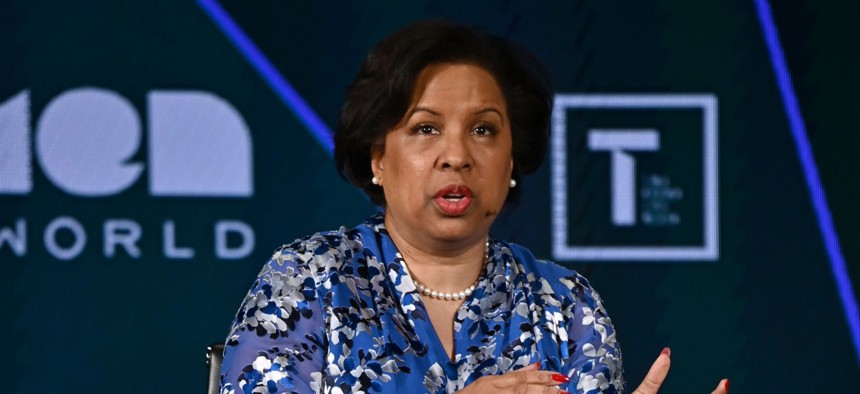SAIC's new CEO gives first glimpse at her short-term focus

Toni Townes-Whitley speaking at the 10th Anniversary Women In The World Summit - Day 2 on April 11, 2019, in New York City. Mike Coppola via Getty Images
In her first conversation with Wall Street, Toni Townes-Whitley points to the scale of Science Applications International Corp.'s portfolio and business development as where most of her initial attention is.
Toni Townes-Whitley has been in the CEO role at Science Applications International Corp. for two months and has spent much of that time "listening and learning" about the company she now leads.
That exercise also has led to her work on "forming and testing certain hypotheses" to help create the next iteration of SAIC's strategy, she said during the company's fiscal third quarter earnings call with investors Monday.
For Townes-Whitley, the call represented her first public remarks as SAIC's CEO and provides a window into her early observations on where the government technology integrator is today and the direction she thinks it may need to go in.
We are attaching a portion of Townes-Whitley's opening remarks to analysts here, in which you will see those observations and initial plans. CEO transitions at public companies always are events of curiosity for all of their stakeholders, which includes employees, investors and customers.
Townes-Whitley said that one of her initial priorities has been to evaluate whether Reston, Virginia-headquartered SAIC's portfolio is at enterprise scale and able to evolve into greater profitability through its solutions.
She acknowledged that SAIC has "a few gaps to close" on that front, but the majority of the business is there in her opinion.
"Recent investments have been made in digital engineering, secure data analytics, operational AI, multilevel security, different forms of technology differentiation combined with the way we deliver in an open systems architecture with various approaches have yielded differentiation and mission relevant integrated solutions," Townes-Whitley told analysts.
"We do have to improve on value creation processes within once we've gotten into a contract with the customer, do we know how to increase value, both on the profitability side for our company as well as for the customer itself, and whether our differentiators are systematically deployed across our enterprise, which we still have some room to grow there," she added.
Then there are the acquisitions SAIC has completed between 2019 and 2021: Engility, the former Unisys federal business, Koverse, and more recently Halfaker and Associates.
Townes-Whitley indicated that SAIC's near-term focus will be on demonstrating more consistent organic growth, which means heightened scrutiny on internal processes and leaning toward investments that support the current book of business.
"Organizations that can show a track record of organic growth with their own portfolio tend to do better over time in terms of being able to identify targets and do successful inorganic activity," Townes-Whitley said. "We are open to and we'll always be open to excellent M&A, but a little more skeptical on the large scale at this point."
Like other government tech contractors, SAIC's business development and capture function is the organic growth engine responsible for creating that track record Townes-Whitley described.
In the opening remarks, she explained how one of her initial key hires,Tim Turitto, will oversee the company's new enterprise business development organization for standardizing and optimizing BD efforts.
SAIC's book-to-bill ratio for the trailing 12 months is 0.9x, a metric that measures growth in the backlog versus drawdowns from it to book revenue. The company also reported a total backlog of $23 billion as of its fiscal third quarter end on Nov. 2.
"That's one of the first organizational structural changes I've made to drive, more rigor, increase the velocity and volume and quality of our bids and enhance our program execution in that direction," Townes-Whitley said of SAIC's BD function.
She did not exclusively give that description for new business opportunities, but also on the recompete front given a string of losses that have weighed on growth.
"When we think about recompete, the idea here is that our lessons learned across our business in unique domains are applied, which is why we've gone to an enterprise business development function," she said. "So that we don't have unique pockets of knowledge, but we have a standard higher quality of enterprise understanding of how to best win a recompete."
Fiscal third quarter revenue of $1.9 billion was 1% lower overall compared to the prior year period. But that rate adjusts to a 10.6% organic increase after adjusting for SAIC's sale of the supply chain and logistics business to ASRC Federal, plus the restructuring of a Forfeiture Support Associates joint venture co-owned with Amentum.
Profit of $178 million represented a 5% year-over-year increase in adjusted EBITDA (earnings before interest, taxes, depreciation and amortization).
SAIC lifted its fiscal year financial outlook to a revenue range of $7.325 billion-to-$7.35 billion, up from the prior outlook of $7.20 billion-to-$7.25 billion, which indicates organic growth of 6%. The company held its margin expectation at 9.3%-to-9.4% adjusted EBITDA.
For its 2025 and 2026 fiscal years, SAIC raised its organic growth goals to 2.5% and 3% respectively. Those are also increases from what the company originally gave at its investor day in April.
Below is an interview with Townes-Whitley that CNBC aired on Monday:
